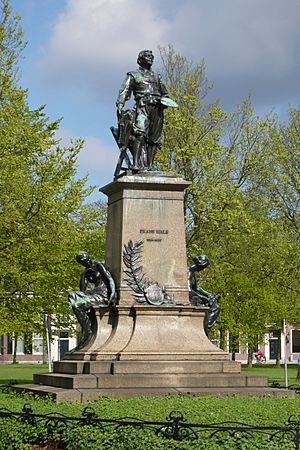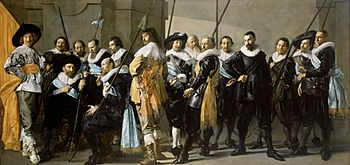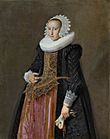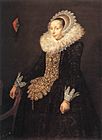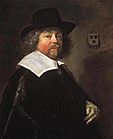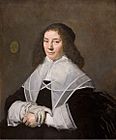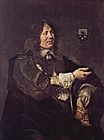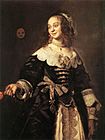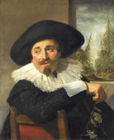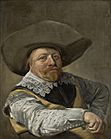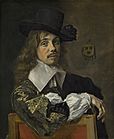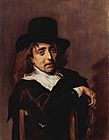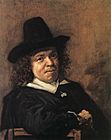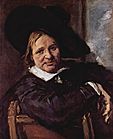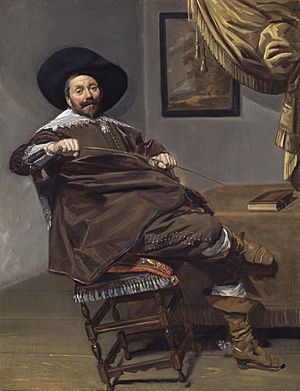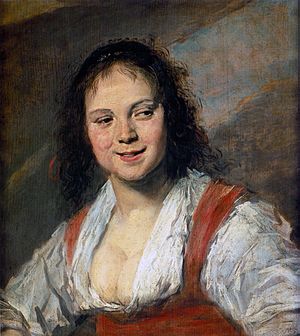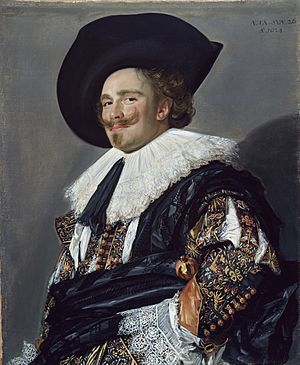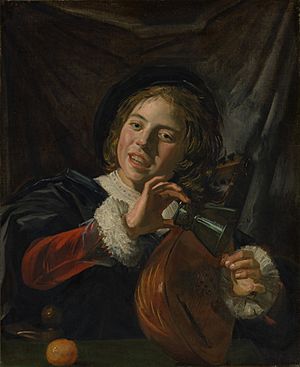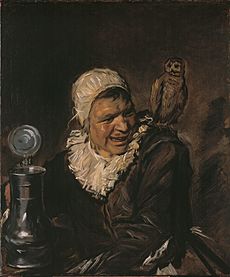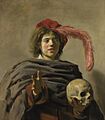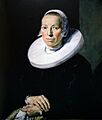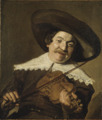Frans Hals facts for kids
Quick facts for kids
Frans Hals
|
|
|---|---|
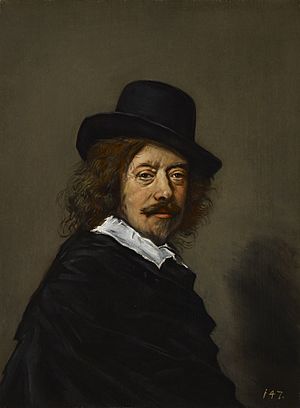
Copy of a Self-portrait by Frans Hals
|
|
| Born | c. 1582 |
| Died | 26 August 1666 (aged 83–84) |
| Nationality | Dutch |
|
Notable work
|
The Gypsy Girl (1628) Laughing Cavalier (1624) Laughing Boy (c. 1625) |
Frans Hals (born around 1582 – died August 26, 1666) was a famous Dutch Golden Age painter. He mostly painted portraits of people, both alone and in groups. He also created genre works, which are paintings showing scenes from everyday life. Hals lived and worked in the city of Haarlem, in what is now the Netherlands.
He was very important in developing 17th-century group portraits. Hals is known for his unique painting style. He used loose, visible brushstrokes, which made his paintings look very lively.
Contents
Frans Hals's Life Story
Frans Hals was born in 1582 or 1583 in Antwerp. This city was then part of the Spanish Netherlands. His father was a cloth merchant named Franchois Fransz Hals.
Like many families, Hals's parents moved to Haarlem in the new Dutch Republic. They left Antwerp during a difficult time (1584–1585). Frans Hals lived in Haarlem for the rest of his life. He studied art with a Flemish artist named Karel van Mander.
Starting His Art Career
In 1610, Hals joined the Haarlem Guild of Saint Luke. This was a group for artists. He began earning money by restoring art for the city council. He worked on their large art collection.
The city council had taken many Catholic religious artworks. These works were later sold or kept for the town hall. Because of this, there was less demand for religious paintings. Hals then focused on painting portraits of people.
His first known painting is a portrait of Jacobus Zaffius from 1611. Hals became famous with his large group portrait, The Banquet of the Officers of the St George Militia Company in 1616. One of his most famous subjects was the philosopher René Descartes, whom he painted in 1649.
Family Life
Frans Hals married his first wife, Anneke Harmensdochter, around 1610. They had three children together. Sadly, Anneke died in 1615, shortly after their third child was born. Only one of their children, Harmen Hals, survived childhood.
In 1617, Hals married Lysbeth Reyniers. They had eight children together. Hals was a dedicated father to all his children.
Unlike some other artists like Rembrandt, Hals stayed in Haarlem. He preferred his customers to come to him for their portraits. This means that everyone he painted was either from Haarlem or visiting the city.
Later Years and Challenges
Frans Hals's paintings were popular for most of his life. However, he lived a very long time, and his style eventually went out of fashion. He faced money problems later in life.
Besides painting, he also worked as an art restorer and art dealer. He even helped the city council with art taxes. He had to sell his belongings in 1652 to pay off debts. In 1664, the city gave him a yearly payment of 200 florins. This was very unusual and showed how much they respected him.
Hals was a member of the local schutterij, which was a military guild. He painted this group three times. He also became the chairman of the Guild of St Luke in 1644.
Frans Hals died in Haarlem in 1666. He was buried in the Grote Kerk church. After his death, his wife received help from the local almshouse.
Frans Hals's Art Style
Hals is most famous for his portraits. He painted many wealthy citizens, like Pieter van den Broecke and Isaac Massa. He also created large group portraits for local civic guards and hospital leaders.
He was a Dutch Golden Age painter known for his realistic and free style. His paintings show different kinds of people from society. These include officers, guild members, city officials, and even street performers.
In his group portraits, like The Banquet of the Officers of the St Adrian Militia Company in 1627, Hals captured each person uniquely. Their faces look real, not perfect. You can see their different personalities through their poses and expressions.
Hals loved using natural daylight in his paintings. He was very skilled at showing a moment in time with his subjects. He could capture exact colors, light, and shadows with just a few quick brushstrokes. He became a popular portrait painter for special events like weddings.
Wedding Portraits
Hals often painted married couples on separate panels. The husband was usually on the left panel, and the wife on the right. Many of these pairs have since been separated.
His early works, like Two singing boys with a lute and a music book, show great detail. Over time, his style became freer. He used fewer colors, often focusing on black. This was likely because his subjects, who were often Protestants, wore simple, dark clothing.
You can see this change by looking at his portraits where people lean over the back of a chair:
Later Portrait Style
Later in his life, Hals's brushstrokes became even looser. Fine details became less important than the overall look. His earlier paintings were cheerful, but his later portraits showed more seriousness and dignity.
This serious style is seen in Regents of the St Elizabeth Hospital (1641). Two decades later, The Regents and Regentesses of the Old Men's Almshouse (around 1664) are also masterpieces. In these, his colors are very limited, almost all black and white. His skin tones became grayer over the years.
Some historians think he used more black and white because these colors were cheaper. Hals also didn't travel to his subjects; they came to his studio. This made him very efficient, but it was harder to get work when Haarlem faced tough times.
Hals was not known for painting landscapes or still lifes. He focused almost entirely on portraits. This was common for artists in the 17th century to specialize.
Frans Hals's Painting Technique
Hals was a master at using visible brushstrokes. This was once seen as a flaw in painting. His brushstrokes are clear on the canvas, creating a sense of substance and space.
His style was similar to later artists like Édouard Manet. People sometimes thought Hals painted his works very quickly, "in one go." This isn't quite true. While he sometimes painted without a first sketch (called alla prima), most of his works were built up in layers. He often started with a loose underpainting.
Hals was very daring and skilled. He knew when to stop adding details to a painting. He didn't "paint them to death," as some artists did by adding too much detail.
His first biographer, Schrevelius, wrote about Hals's "unusual manner of painting." He said Hals's portraits had "such power and life" that they seemed to "challenge nature with his brush." Hals was likely inspired by Flemish artists like Peter Paul Rubens and Van Dyck.
Artists Influenced by Frans Hals
Frans Hals influenced his younger brother, Dirck Hals (1591–1656), who was also a painter. Five of Frans's sons also became painters:
- Harmen Hals (1611–1669)
- Frans Hals the Younger (1618–1669)
- Jan Hals (1620–1654)
- Reynier Hals (1627–1672)
- Nicolaes Hals (1628–1686)
Most of his sons painted portraits. Some also painted still lifes or landscapes.
Other artists of his time who were inspired by Hals include:
- Jan Miense Molenaer (1609–1668)
- Judith Leyster (1609–1660), who was married to Molenaer
- Adriaen van Ostade (1610–1685)
- Adriaen Brouwer (1605–1638)
- Johannes Cornelisz Verspronck (1597–1662)
- Bartholomeus van der Helst (1613–1670)
Hals had a large workshop and many students in Haarlem. Some of his known students include Philips Wouwerman, Adriaen Brouwer, and Adriaen van Ostade. Pieter Gerritsz van Roestraten was not only a student but also married Hals's daughter, Adriaentje. Judith Leyster is also considered a possible student because her painting style is very similar to Hals's.
In the 19th century, Hals's technique influenced Impressionist and Realist artists. These included famous painters like Claude Monet and Édouard Manet. Vincent van Gogh, a Post-Impressionist artist, greatly admired Hals. He wrote that seeing a Frans Hals painting was a joy because it was so different from other smooth, detailed works. Hals used smears, lines, and large patches of color to show the life in his subjects.
Frans Hals's Legacy
After his death, Frans Hals's fame declined for about 200 years. Some of his paintings, which are now very valuable, were sold for very little money. For example, a portrait of Johannes Acronius sold for only five shillings in 1786.
However, some artists and collectors still appreciated his work. Arnold Houbraken, an early biographer, praised Hals's style. He said the figures in one group portrait "seem to want to talk to us." Empress Catherine the Great of Russia bought ten of his works. Artists like Jean-Honoré Fragonard and Antoine Watteau studied and copied his paintings.
In 1774, Joshua Reynolds lectured on Hals in London. He praised Hals's ability to paint faces with great individuality. Reynolds later bought two of Hals's paintings.
In the mid-1860s, Hals's reputation grew again, thanks to the art critic Théophile Thoré-Bürger. With this renewed interest, the value of his paintings soared. For instance, a large family group painting was bought by the National Gallery for £25,000 in 1908.
Today, Hals's work is still admired, especially by young painters. They learn a lot about painting techniques from his visible brushstrokes. His paintings are found in museums around the world, from London to New York.
Many of his most important works are owned by the city of Haarlem. They are now displayed at the Frans Hals Museum in Haarlem. Before 1913, they hung in the Town Hall, where Impressionist painters would go to see them.
The Hals crater on the planet Mercury is named after him. He was also featured on the Netherlands' 10-guilder banknote in 1968.
Public Collections (Selection)
- Frans Hals Museum, Haarlem
- Frick Collection, New York City
- Koninklijk Museum voor Schone Kunsten Antwerpen
- Louvre, Paris
- Mauritshuis, The Hague
- Metropolitan Museum of Art, New York
- Museum Boijmans Van Beuningen, Rotterdam;
- Museum of Fine Arts, Boston
- Rijksmuseum Amsterdam.
- Kenwood House
- Wallace Collection, London
Images for kids
-
Young Man with a Skull, c. 1626–1628, National Gallery, London
-
Portrait of a Man (about 1665), Museum of Fine Arts, Boston
See also
 In Spanish: Frans Hals para niños
In Spanish: Frans Hals para niños
- List of paintings by Frans Hals
- Han van Meegeren


